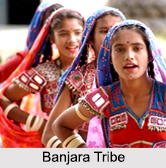 Banjara Tribe is a significant caste amongst the innumerable tribes who have thronged various places of eastern India. They are considered the caste of carriers. They constitute the "smallest" tribal population in Jharkhand and these tribes are grouped under the "scheduled tribes" group of the state. They are the typical nomads who wander from one place to another thus leading a life in their own terms and condition. Thus, their way of living is quite thrilling and full of adventures. They are skilled weavers and make mats, baskets, trays, brooms, etc. from grass growing wild in the forest.
Banjara Tribe is a significant caste amongst the innumerable tribes who have thronged various places of eastern India. They are considered the caste of carriers. They constitute the "smallest" tribal population in Jharkhand and these tribes are grouped under the "scheduled tribes" group of the state. They are the typical nomads who wander from one place to another thus leading a life in their own terms and condition. Thus, their way of living is quite thrilling and full of adventures. They are skilled weavers and make mats, baskets, trays, brooms, etc. from grass growing wild in the forest.
Origin of Banjara Tribe
The origin of the Banjara tribes is quite interesting. According to scholars, the first mention of the Banjaras is found in the history of Sikandar Lodi"s attack on Dholpur in 1504 AD. They came to the Deccan following the invasion by the armies of Aurangzeb. According to some authorities, the actual Banjara lineage goes back to some 2000 years. After setting down in Rajasthan, Banjaras began to travel down to the South in the 14th century. A local dialect namely, Kutni too is popular amongst a section of Banjara tribes.
Divisions of Banjara Tribe
Banjara tribes have four main divisions in Berar, namely, Mathurias, Dharis, Charans and Labhanas. The name Charan basically means wanderer. Charans have five clans - Panwar, Puri, Rathor, Jadon and Chauhan. These are the names of leading Rajput clans. Each clan of Banjara tribe has several sub-clans. Members within the same clan do intermarry. There are other divisions apart from these four main divisions. There are two Muhammadan sections in this caste namely Mukeri and Turkia.
 Marriage Rituals of Banjara Tribe
Marriage Rituals of Banjara Tribe
Banjara marriage has been celebrated adding their social rituals in their own fervour. At the time of marriage also special customs and norms are being followed. The couple then holds hands and does seven rounds of grain pounding with pestles. In Banjara communities, marriages are usually held in rainy season. It is because of the fact that in the dry season, they are regularly travelling. In their society, widow re-marriage is allowed.
Costume of Banjara Tribe
The costumes of Banjara tribe are very colourful. A Banjara woman`s mode of dressing is regarded to be the most colourful as well as elaborate amongst all other tribal communities of India. A woman of Banjara tribes is quite accustomed to the costume ghagra-lehenga-choli. Jewelleries become an integral part of the body. Long silver earrings are very common things to wear and also patterned cowries adorn the hairs plaits of a Banjara woman.
Culture of Banjara Tribe
Culture of Banjara tribes is quite enriched. Since majority of Banjara tribes are Hindus, they diligently perform all the rites and rituals of the Hindus. Just like any other Indian tribal community, dance and music constitute an integral part of their celebration during festivals.
Festivals of Banjara Tribe
Festivals are part and parcel of Banjara tribal community. Apart from celebrating few popular festivals of India like Holi, Dussehra, they too fete some of their folk festivals in great enthusiasm and vigour. For these pious Banjara, religious festivals too are very popular. Family deities are revered to a great extent.
















